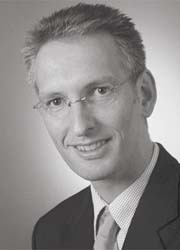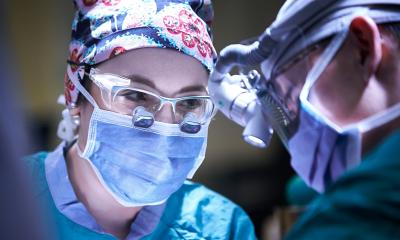Anaesthesiology today
Ever since Boston surgeon John Collins Warren commented on the first successful ether anaesthesia at Harvard University with the now famous words, ‘Gentlemen, this is no humbug!’ anaesthesiology has developed into a separate and modern medical discipline.

The story of anaesthesiology is a story of success unparalleled in modern medicine. Despite the fact that, in Germany, anaesthesiology as a profession does not look back on a particularly long tradition - the German Society for Anaesthesiology and Intensive Medicine (Deutsche Gesellschaft für Anästhesiologie und Intensivmedizin - DGAI) celebrates its 55th anniversary this year – it was here that anaesthesiology was expanded significantly beyond its originally one-dimensional task of intra-operative anaesthesia. Modern anaesthesiology follows a truly interdisciplinary approach – it links anaesthesia with surgical critical care; plays an important role in the treatment and care of trauma patients and provides chronically ill patients with pain and palliative care. Anaesthesiology thus contributes considerably to therapy success.
Due to its excellent training and education programmes, anaesthesiology assumes a leading position in all these disciplines. Current education guidelines in Germany state: ‘Anaesthesiology encompasses general, regional and local anaesthesia, including pre- and post-surgical treatment, maintenance of vital signs during surgical and diagnostic interventions as well as measures in critical, trauma and pain care.’
In short, our discipline today focuses on two core issues: First, anaesthesia, which means insensitivity towards pain and touch. It is the task of the anaesthesiologist to ensure that any invasive medical intervention – be it surgical, therapeutic or diagnostic – is as safe and pleasant as possible for the patient. The anaesthesiologist creates ideal conditions for the intervention and contributes to its success. The expertise required for this core task qualifies the anaesthesiologist for certain areas in pain medicine.
Second, the anaesthesiologist is responsible for monitoring vital signs or managing homeostasis. Anaesthesiological knowledge is crucial when the patient’s vital signs are impaired or at risk during an intervention. Such impairment or risk may result from the required anaesthesiological procedure, the intervention itself, or the patient’s health status, or a combination of these factors. The know-how required for peri-operative management of vital signs qualifies the anaesthesiologist for these tasks in peri-operative critical and trauma care.
In basic, as well as clinical research, anaesthesiologists now contribute to almost all medical disciplines - from cardiovascular research down to neuronal plasticity. Their research results are reflected not only in professional national and international publications but also in interdisciplinary or non-medical publications. On a global scale, the total volume of third party research funds acquired by anaesthesiologists is impressive.
As a so-called cross-cutting or service discipline, anaesthesiology is set to progress towards peri-operative process management. Anaesthesiologists are over-proportionally represented among operating theatre (OT) managers and co-ordinators, as well as medical directors and hospital managers. In these roles, their ability to communicate across disciplines and professions is a particularly valuable and sought-after asset.
Modern anaesthesiology is well positioned and prepared to help tackle the challenges of an ageing society. Interventional medicine is faced with the fact that older patients more frequently than younger patients present with multi-morbidity and polypharmacy, which in turn negatively impact on recovery. Anaesthesiologists and their surgeon colleagues therefore developed ‘fast rehabilitation’, or early recovery programmes that promote better and faster recovery of the patients.
Today, the tasks of need-based peri-operative care go far beyond traditional cardiovascular haemostasis management and encompass peri-operative normothermia, balanced goal-directed fluid therapy, sophisticated catecholamine and haemostasiological therapy and individualised and optimised peri-operative analgesia using regional anaesthesia.
Anaesthesiological outcome research creates a medical and economic advantage for the individual patient and for the entire healthcare system. Most of the surgical interventions would not be possible without the direct transfer of complex new knowledge regarding physiology, pathophysiology of all organ systems into diagnostic and therapeutic anaesthesiological concepts. Or rather such new knowledge would be associated with exorbitantly high morbidity and mortality rates.
Since this complex knowledge-web, as well as its maintenance and its expansion to a competent profession ‘physician of anaesthesiology’ is a time and resource intensive task, political and financial decision makers in hospitals increasingly pressure hospitals to cancel these highly qualified positions. This means, for superficial economic consideration, patients are consciously exposed to a high peri-operative risk. In an attempt to counteract such dangerous economic pressure the Deutsche Gesellschaft für Anästhesiologie und Intensivmedizin (DGAI) published an unequivocal position paper drawing on evidence-based guidelines and criteria.
Sooner than many other disciplines, anaesthesiology developed therapy concepts in the areas of anaesthesiology, critical, trauma and pain care. Particularly in interdisciplinary surgical critical care, anaesthesiology – due to its competency – managed to forge partnerships with surgical disciplines. Due to insights in and direct knowledge of surgery, critical care issues were solved speedily.
The modern anaesthesiologist, who is a knowledgeable partner of both surgical and non-surgical disciplines, requires the combination of anaesthesiological and critical care knowledge. The same holds true, by the way, for nurses working in anaesthesiology and critical care.
Increasing case numbers in surgery, demographic change often accompanied by severe multi-morbidity and increasing cost pressure, require top-quality training in anaesthesiology. The ability to take on this challenge in partnership with the surgical disciplines will secure the future success of anaesthesiology – and the gratitude of many patients.
01.08.2008











